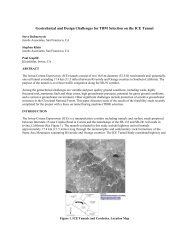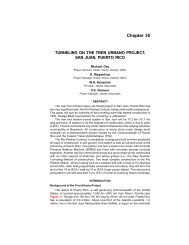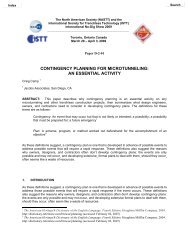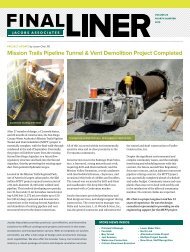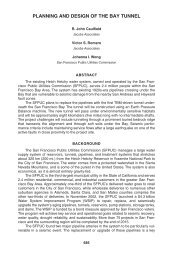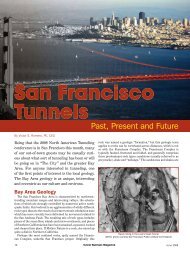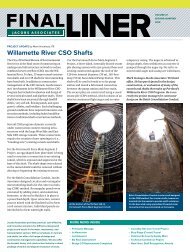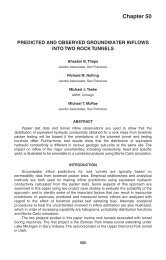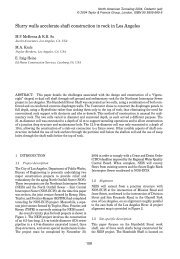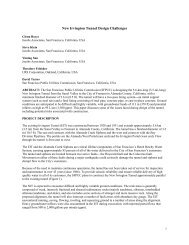Riverside Badlands Tunnel, Inland Feeder Project - Jacobs Associates
Riverside Badlands Tunnel, Inland Feeder Project - Jacobs Associates
Riverside Badlands Tunnel, Inland Feeder Project - Jacobs Associates
You also want an ePaper? Increase the reach of your titles
YUMPU automatically turns print PDFs into web optimized ePapers that Google loves.
CHALLENGES BETWEEN CONCEPT AND COMPLETION 1003<br />
excellent for tunneling, as the TBM cut the ground easily but the ground was strong<br />
enough to have good stand up time and had sufficient silt and clay fines to prevent water<br />
problems. As anticipated, the formation became less cemented, weaker, and sandier as<br />
the tunnel proceeded north. Eventually the weaker, more pervious ground in combination<br />
with the higher groundwater levels led to significant problems about 1 km (3,300 ft) north<br />
of Live Oak Canyon where flowing ground with groundwater inflows in excess of 25 L/sec<br />
(400 gpm) halted the TBM. The water inflows decreased to about 5 to 6 L/sec (80 to<br />
100 gpm), however, mining could not proceed in such unstable ground conditions.<br />
The GDSR anticipated flowing ground being encountered and provided for the<br />
use of chemical grout (sodium silicate) to control this behavior. SBB planned to install<br />
sleeve port pipes for grouting using the lost point drilling method. Before this could be<br />
done, it was necessary to first stabilize the face and ground around the machine. This<br />
was achieved by chemical grouting through short pipes driven into the face and though<br />
holes cut in the shield. After completing this initial grouting, sleeve port grout pipes 9 m<br />
(30 ft) long were installed ahead of the TBM and chemical grout injected. Then the<br />
head was cleared of cobbles that had collected in the buckets and the head was<br />
turned. Mining recommenced but before a full 1.2 m (4 ft) shove could be completed<br />
the ground flowed into the tunnel and mining had to be stopped. This same chemical<br />
grouting process was repeated several times without success over the next 10 weeks,<br />
probably because the grout was not penetrating far enough into the formation to<br />
stabilize enough ground around the tunnel perimeter.<br />
Considering this situation, MWD investigated the feasibility of installing a deep<br />
well from the ground surface in this area. The landowner was agreeable and<br />
dewatering analyses indicated that a well installed to a depth of about 150 m (500 ft)<br />
would be required to draw the groundwater level down to near the tunnel invert. MWD<br />
directed SBB to install a deep well located about 107 m (350 ft) ahead of the tunnel<br />
heading. In addition, drain holes 45 m (150 ft) long were drilled ahead of the TBM and<br />
a pump was installed in a well drilled in the invert of the tunnel.<br />
The deep well was very effective, producing a flow rate of approximately 27 L/sec<br />
(425 gpm), and the drain holes yielded flows of about 6 L/sec (100 gpm) each. The<br />
combined result of these dewatering measures was an immediate improvement in<br />
conditions at the tunnel heading, and mining operations resumed. A second deep well<br />
was also installed approximately 150 m (500 ft) north of the first well to ensure that the<br />
remainder of the reach could be successfully mined. After a total delay of nearly<br />
12 weeks, mining continued at a rate of 27 m/day (90 ft/day) to Reach 3.<br />
Potential flowing ground conditions were also expected in the San Timoteo<br />
Formation in Reach 2. Because of the effectiveness of the dewatering wells in Reach 4<br />
and the difficulty in grouting from the tunnel, it was decided to use the dewatering<br />
approach for Reach 2. Five wells were installed and they proved to be very effective in<br />
controlling the flowing ground and Reach 2 was mined without incident.<br />
Final Lining<br />
The Contract allowed the contactor to install a final lining of either reinforced<br />
concrete cylinder pipe or welded steel pipe. SBB selected the steel pipe option and<br />
elected to fabricate the pipe in 18 m (60 ft) sections with lap welded joints. The tunnel<br />
was prepared for the pipe laying operation and particular attention was given to<br />
installing a panning system that allowed water to be drained to the invert while<br />
ensuring that the LDCC would not infiltrate and plug the drains. Once proper drainage<br />
was established, the steel pipes were installed in the tunnel using a special pipe carrier<br />
designed by SBB. The pipe was transported and installed at a rate of about 120 m<br />
(400 ft) or 7 sections per day. After installing and welding the pipe sections, stulls were



